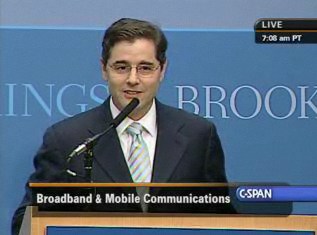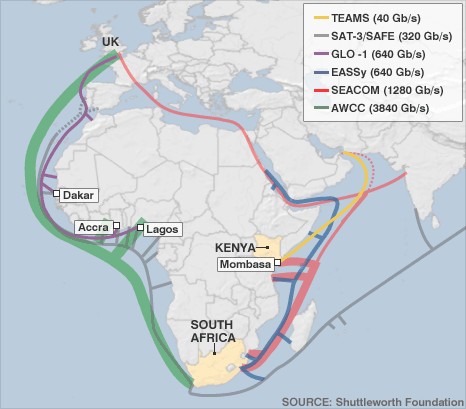Competition does occasionally bring lower prices, but only to those who threaten to abandon their current provider to take their business elsewhere.
Residents in several suburbs of Syracuse, New York have learned that trick as Verizon nears the launch of FiOS service in their area, and the result is significant savings of more than $240 a year, just for the asking.
“Where we find the competition really paying off is for those consumers who might already be with Time Warner,” Doug Williams, a Cambridge-based analyst with Forrester Research told the Syracuse Post-Standard. “People whose promotional deals are ending are often able to get a sweet deal with nothing more than a phone call and a mention of the word “FiOS.”
It worked for Doug himself up in Boston, where his mother is served by Comcast:
Doug Williams had a fool-proof plan for his mother-in-law to get at least $20 knocked off her cable bill: Call the cable company and tell them Verizon FiOS television was in her neighborhood.
It worked without a hitch. The operator looked up her address, then gave her a discount without any hesitation. Williams’ family lives in the Boston area, where Verizon’s fiber optic television service is the first real competition to the area’s entrenched cable provider, Comcast.
The Syracuse suburbs of Clay, Cicero, East Syracuse, North Syracuse and Fleming already have, or will soon have access to FiOS. The towns of DeWitt and Salina last week approved franchise agreements with Verizon to provide the service, and Camillus approved the franchise agreement on August 25.
The addition of the Camillus television franchises brings to 161 the total number of New York municipalities that have authorized Verizon to provide FiOS TV service.
The company is in the process of building and installing the necessary video equipment in local central offices in the central New York region, and anticipates that FiOS TV service will be turned on for new customers in
municipalities there in the fall.
[flv width=”296″ height=”222″]http://www.phillipdampier.com/video/WSYR Syracuse FiOS Coming to CNY.flv[/flv]
WSYR-TV Syracuse covers the announcement by Clay officials of Verizon’s first franchise agreement in the area. (3/16/2009)
Time Warner Cable has been preparing for Verizon for at least a year, starting with complaints about how the franchise agreement was handled in Clay, where Time Warner officials claimed they were given insufficient notice to review the franchise proposal. That claim was brushed aside by the New York Public Service Commission, which has a history of rubber stamping franchise proposals anyway. Time Warner has had little to say about other franchise agreement negotiations since.
The cable company has also been wringing its hands about fears Verizon’s construction crews will be digging up their customers’ lawns, making a mess, and accidentally interrupting service for their customers. Time Warner’s concerns may have come in part from a WSYR-TV report back in June highlighting the frustrations of Clay residents who have been inconvenienced by Verizon’s slow work in their area. But most consumers welcome the competition.
[flv width=”296″ height=”222″]http://www.phillipdampier.com/video/WSYR Syracuse Preparing for FiOS.flv[/flv]
WSYR-TV Syracuse highlights the plight of Clay residents running out of patience as Verizon wires their community for FiOS. (6/4/09)
“People are excited. It looks like there will be an opportunity for choice,” Cicero town supervisor Chet Dudzinski told the newspaper.

Verizon FiOS installation crews start to wear out welcome in Clay, N.Y.
Time Warner claims it’s not worried by the competition, noting it successfully competes in many other FiOS-wired communities. But Time Warner’s marketing efforts have changed with the looming threat of competition. First, the company brought a “price protection agreement” to the area, trying to lock in existing customers to a lengthy contract before the competition arrived, limiting their chances to switch providers. Then the company embarked on a major HD channel expansion, quickly bringing Syracuse residents more than 100 HD channels. Time Warner promoted their heavy emphasis on local sports programming, touting Syracuse University football and basketball games, and local high school sports coverage.
Verizon shot back they will feature more than 115 HD channels, and 70% of their 15,000 videos on demand are available for free. Verizon also will carry many Syracuse sports events, and will also bring NFL Network and ESPN 360 to the area, services Time Warner has refused to carry.
Consumers enjoy the competitive choice, and with the possibility walking their cable and broadband service to the “other guy” across town, will be able to leverage some additional savings off their service.
For Syracuse city residents, the wait will be somewhat longer. City officials are wrangling over the kinds of public access programming and service policies Verizon will be required to provide before they will negotiate a franchise agreement with them. The foot dragging may last a year or longer, as the city will vote Monday on whether to spend $30,000 of taxpayers’ money just to ascertain what the city needs from Verizon when negotiations begin. City residents who want competition now may want to inform their elected officials spending $30,000 to “study” the issue is just a tad excessive, especially considering The Google provides ample information, for free, about what other communities across the northeast have accomplished as part of their negotiations with the dominant phone company in the region.
Verizon’s complete list of franchises in New York state is below the jump.
… Continue Reading


 Subscribe
Subscribe



